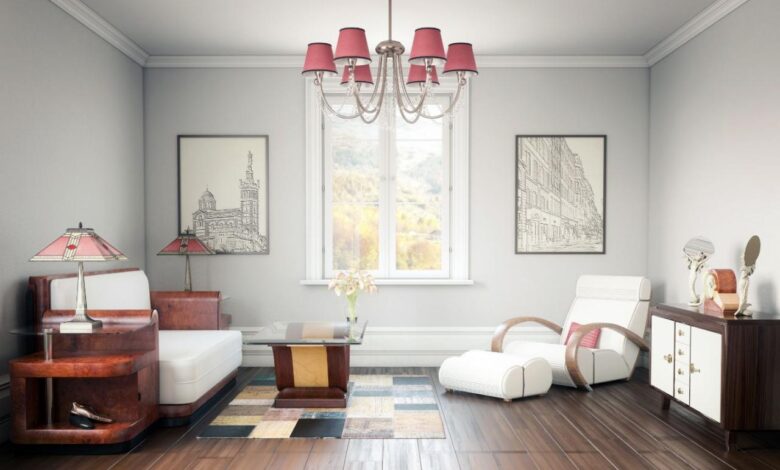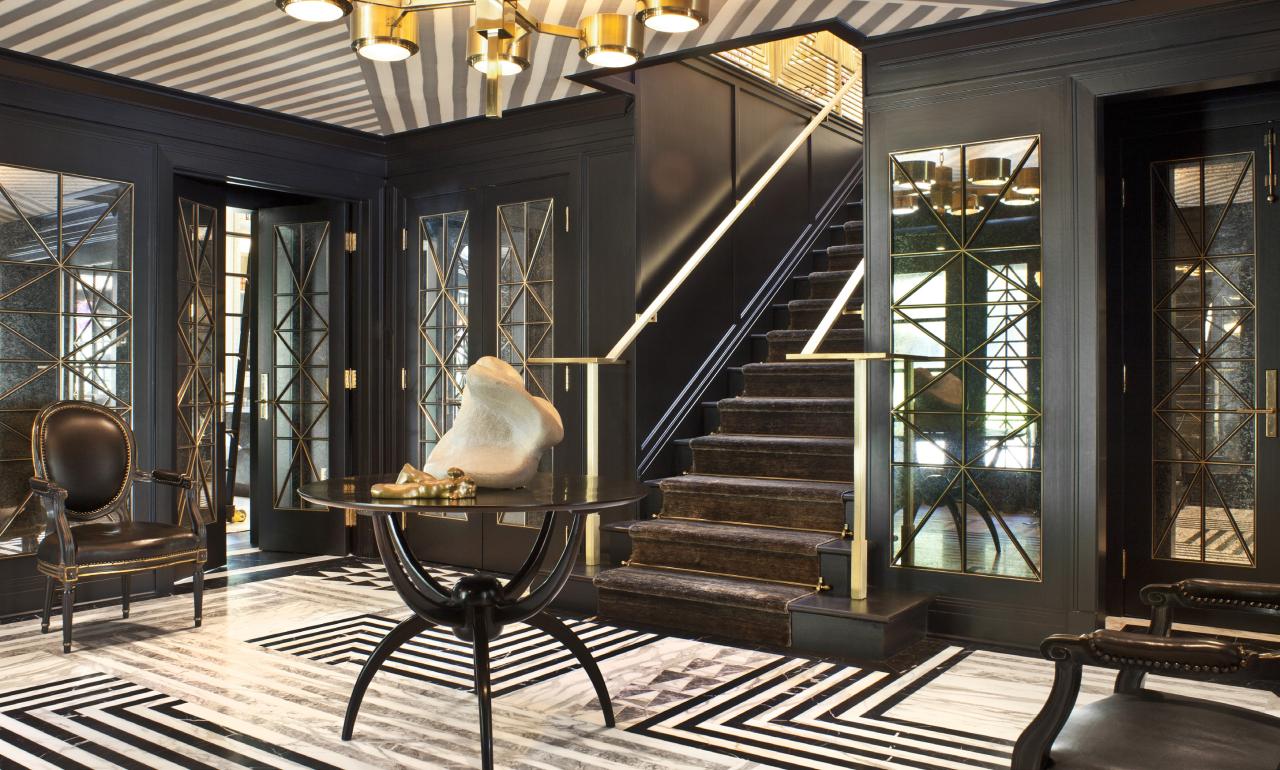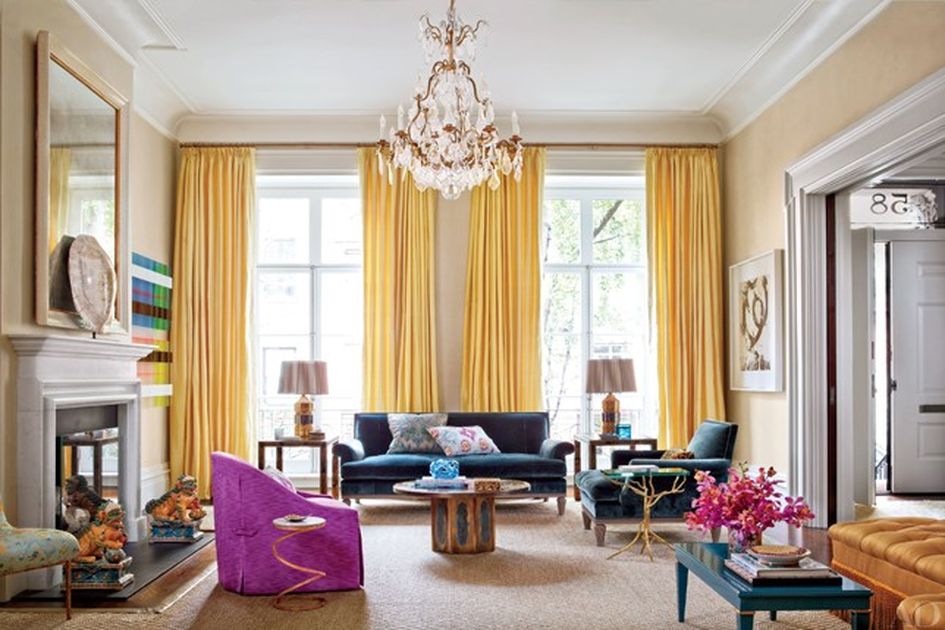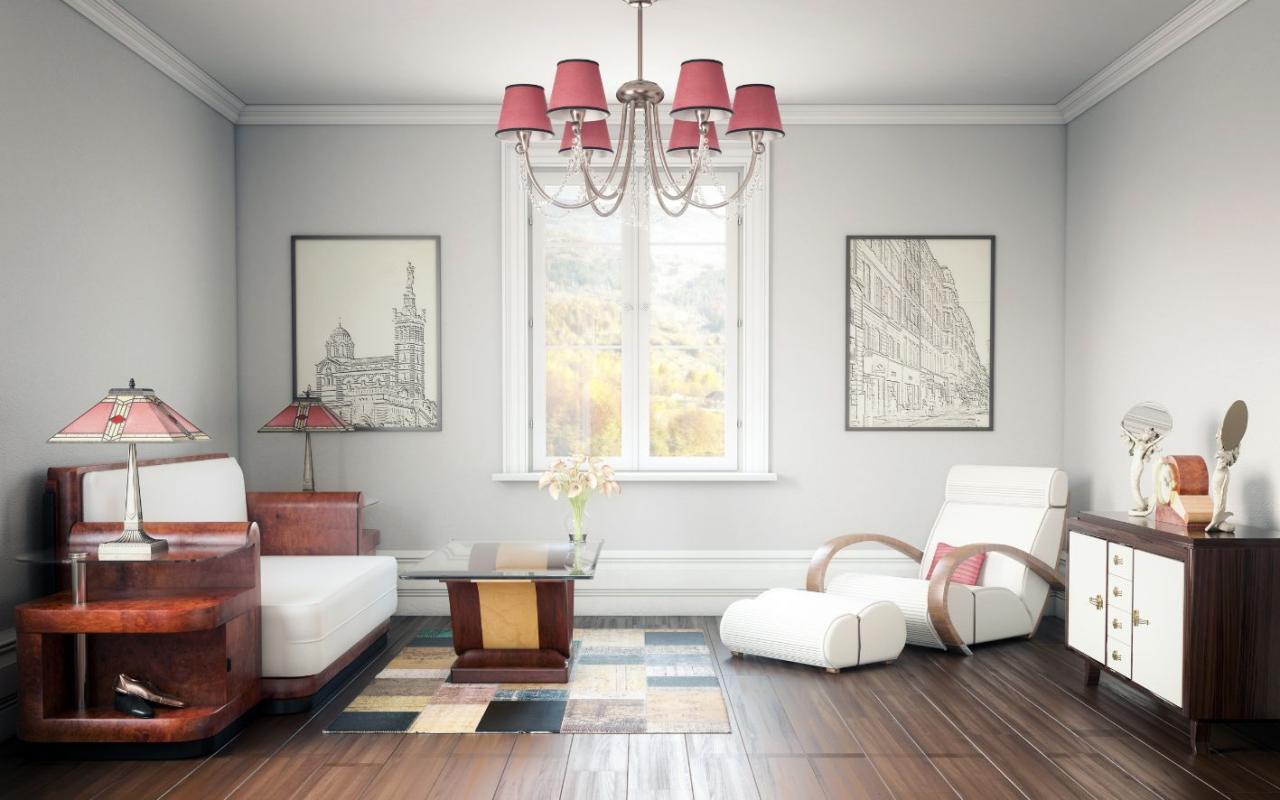
Best Art Deco Patterns A Visual Feast
Best Art Deco patterns? Let’s dive into the dazzling world of geometric shapes, vibrant colors, and striking symmetry! From its origins in the 1920s, Art Deco captivated the world with its bold and luxurious aesthetic, influencing everything from architecture and fashion to graphic design and product design. This post explores the evolution, categorization, and enduring appeal of these iconic patterns, showcasing their unique features and lasting impact on modern design.
We’ll uncover the secrets behind their creation, examining the historical context, key influences like Cubism and industrial design, and how societal shifts of the era shaped their development. Get ready to be inspired by the rich history and timeless elegance of Art Deco patterns – you might just find your new favorite design inspiration!
Defining Art Deco Patterns

Source: inspirationdesignbooks.com
Art Deco patterns, a visual hallmark of the Art Deco movement (roughly 1920-1939), are characterized by their geometric precision, luxurious feel, and often bold, vibrant color palettes. They reflect the era’s fascination with technology, industrial design, and a sense of streamlined elegance. These patterns weren’t just decorative; they expressed a modern aesthetic that embraced both order and opulence.Art Deco patterns are defined by their distinct features, making them easily recognizable.
Their impact on design continues to this day, influencing everything from fashion and architecture to graphic design and interior decor.
Geometric Shapes in Art Deco Patterns
The foundation of most Art Deco patterns lies in their use of geometric shapes. These shapes are rarely organic or free-flowing; instead, they’re precise and often sharply defined. The emphasis is on clean lines and clear forms. Common shapes include zigzags, chevrons, sunbursts, stepped pyramids, and radiating lines. Think of the sharp angles of skyscrapers reflected in the patterns themselves – a deliberate mirroring of the architectural style of the time.
Rectangles, squares, and triangles are also frequently employed, often arranged in repeating motifs to create a sense of rhythm and structure. Circles and stylized floral elements, when used, are typically rendered in a geometric rather than naturalistic way.
Symmetry and Asymmetry in Art Deco Patterns
While symmetry is a common feature in Art Deco, the movement also embraced controlled asymmetry. Symmetrical patterns often utilize mirrored repetitions of geometric forms, creating a balanced and harmonious effect. Think of a perfectly mirrored chevron pattern, or a symmetrical arrangement of sunbursts. Asymmetrical designs, however, don’t abandon order entirely. Instead, they might feature a carefully balanced arrangement of different geometric shapes or a subtle off-center placement of elements, adding a touch of dynamism to the overall composition.
This balance between order and controlled irregularity is key to the Art Deco aesthetic.
Color Palettes in Art Deco Patterns
The color palettes associated with Art Deco patterns are as distinctive as their shapes. Rich, deep colors were favored, often in bold combinations. Think of jewel tones like emerald green, sapphire blue, ruby red, and amethyst purple. These colors were often paired with metallic accents such as gold, silver, and platinum, reflecting the era’s fascination with luxury and opulence.
Black and white were also frequently used, either as a background or in contrast with the more vibrant hues, providing a sharp and sophisticated contrast. The overall effect is one of refined glamour and sophisticated modernity.
Evolution of Art Deco Patterns: Best Art Deco Pattern
Art Deco, a style synonymous with glamour and geometric precision, didn’t emerge fully formed. Its distinctive patterns evolved over time, absorbing influences and reflecting the changing social and technological landscape of the early 20th century. Understanding this evolution reveals a fascinating interplay of artistic movements and societal shifts.Art Deco patterns, at their inception, drew heavily from the preceding artistic movements.
The sharp angles and fragmented forms of Cubism, for example, are clearly visible in early Art Deco designs. However, unlike the often-abstract nature of Cubism, Art Deco embraced a more streamlined and decorative aesthetic, incorporating these angular elements into highly stylized and often symmetrical patterns. This early phase also saw the incorporation of elements from other styles, including the geometric precision of ancient Egyptian art and the stylized natural forms found in Art Nouveau.
The result was a unique blend of influences, creating a distinctly modern yet sophisticated visual language.
Early Art Deco Patterns: Cubist Influences and Geometric Abstraction
Early Art Deco patterns, emerging in the 1920s, often featured bold geometric shapes – zigzags, chevrons, sunbursts, and stepped pyramids – arranged in symmetrical compositions. These designs often incorporated strong vertical and horizontal lines, creating a sense of order and stability, a visual reflection of the era’s optimism and belief in progress. The influence of Cubism is evident in the fragmentation of forms and the use of overlapping planes, but unlike the chaotic energy of Cubism, Art Deco patterns are characterized by a sense of controlled dynamism and elegance.
Think of the iconic stepped patterns found in architecture, textiles, and posters of the period – they exemplify this early stage of geometric abstraction. For instance, a typical design might involve a repeating motif of stylized sunbursts, meticulously arranged to create a balanced and visually arresting pattern.
Later Art Deco Patterns: Streamlining and Industrial Influences
As the 1930s progressed, Art Deco patterns underwent a significant shift. The influence of industrial design became increasingly prominent, leading to a greater emphasis on streamlining and aerodynamic forms. Curves and flowing lines began to replace the rigid geometry of the earlier years. This is exemplified by the emergence of patterns incorporating stylized nautical motifs, such as ocean liners and propeller shapes, reflecting the technological advancements and the growing fascination with speed and travel that characterized the era.
The sleek, elongated forms found in many later Art Deco designs mirror the aesthetics of the newly emerging industrial designs. For example, the streamlined patterns found on the exteriors of ocean liners, such as the Normandie, are a perfect example of this evolution.
Societal Reflection in Art Deco Patterns
Art Deco patterns didn’t exist in a vacuum; they were deeply intertwined with the social and cultural changes of their time. The optimistic spirit of the Roaring Twenties is reflected in the exuberant energy and bold geometric designs of early Art Deco. The rise of industrialization and technological advancement is evident in the streamlined forms and the incorporation of machine-inspired motifs in later Art Deco.
The patterns themselves served as a visual representation of the era’s aspirations for progress, modernity, and a more streamlined, efficient future. The emphasis on order and symmetry also reflected a desire for stability and control in a rapidly changing world. The decorative exuberance of Art Deco, in contrast to the austerity of the post-war period, further reflects the specific cultural context of its creation.
Categorizing Art Deco Patterns
Art Deco, with its geometric precision and luxurious aesthetic, employed a vast array of patterns. Understanding these patterns requires categorization to appreciate their diversity and the stylistic nuances within the movement. This section explores a structured approach to classifying these iconic designs.
Geometric Abstractions
Geometric patterns form the bedrock of Art Deco design. These patterns often feature clean lines, sharp angles, and repetitive motifs, creating a sense of order and sophistication. They frequently utilize strong contrasts in color and value to emphasize the geometric forms.
| Category Name | Description | Example Pattern Description | Representative Image Description |
|---|---|---|---|
| Geometric Abstractions | Patterns based on geometric shapes like triangles, squares, circles, and zigzags, often arranged in repeating symmetrical or asymmetrical designs. | A pattern featuring interlocking triangles in alternating shades of deep teal and gold, creating a dynamic, almost three-dimensional effect. | A vibrant image depicting a close-up view of the aforementioned pattern. The sharp angles of the triangles are clearly defined, and the contrast between the teal and gold is striking. A subtle texture is suggested, perhaps hinting at a metallic or embossed surface. The overall impression is one of bold elegance and modern sophistication. |
| Floral and Botanical Motifs | Stylized representations of flowers, leaves, and other botanical elements, often simplified and geometrically arranged. | A pattern showcasing stylized lilies, with elongated petals and geometrically precise leaves, arranged in a repeating vertical band. The lilies are rendered in shades of deep crimson and emerald green against a background of cream. | The image displays a rich, almost tapestry-like quality. The stylized lilies are not photorealistic but maintain a sense of elegance and natural grace. The colors are deep and saturated, and the arrangement creates a sense of vertical movement and rhythm. The overall feeling is one of luxurious opulence. |
| Sunburst and Radial Patterns | Patterns radiating outwards from a central point, often mimicking the effect of a sunburst or starburst. | A pattern composed of radiating lines emanating from a central point, creating a dynamic and energetic feel. The lines are subtly graduated in tone, from a deep navy blue at the center to a lighter, almost silver-grey at the edges. | The image shows the pattern with a sense of depth and movement. The gradual change in color creates a subtle glow, suggesting light radiating from the center. The lines are precise and sharp, conveying a sense of speed and dynamism. The overall effect is one of dazzling brilliance and energetic movement. |
| Chevron and Zigzag Patterns | Patterns based on repeating chevron or zigzag motifs, often creating a sense of movement and energy. | A pattern consisting of interlocking chevrons in a palette of warm browns and golds, evoking a feeling of richness and sophistication. The chevrons are subtly textured, creating a subtle visual interest. | The image conveys a feeling of warmth and luxury. The color palette is rich and inviting, and the subtle texturing of the chevrons adds depth. The pattern has a rhythmic quality, creating a sense of visual flow. The overall impression is one of elegant simplicity and understated luxury. |
Applications of Art Deco Patterns

Source: grid.id
Art Deco patterns, with their geometric precision and luxurious feel, weren’t merely decorative; they were integral to the aesthetic and functionality of a wide range of applications during the 1920s and 30s, and continue to inspire designers today. Their impact extended far beyond mere ornamentation, shaping the visual landscape of entire industries and influencing how we perceive design even now.
The versatility of these patterns allowed for seamless integration across diverse mediums, resulting in a cohesive and strikingly modern style.Art Deco’s influence permeated numerous sectors, leaving an indelible mark on the design world. The patterns’ inherent elegance and sophistication resonated with the era’s desire for modernity and luxury, contributing significantly to the overall aesthetic of the time. This section will explore specific examples of this widespread application.
Art Deco Patterns in Architecture
Art Deco’s impact on architecture is undeniable. Buildings from this era frequently incorporated geometric patterns into their facades, often using stylized sunbursts, zigzags, and stepped forms. The Chrysler Building in New York City, for instance, is a prime example, showcasing stainless steel elements and intricate detailing that perfectly embody the style. The geometric patterns on its spire, along with the stepped setbacks of the building, create a dynamic and visually arresting effect.
Other notable examples include the Eastern Columbia Building in Los Angeles, with its vibrant turquoise facade and repeating geometric motifs, and the Barclay Vesey Building in New York, which features a striking zig-zag pattern on its exterior. These architectural marvels demonstrate how Art Deco patterns could be used on a grand scale to create iconic and memorable structures.
Art Deco Patterns in Fashion
The streamlined elegance of Art Deco patterns translated beautifully into fashion. Bias-cut dresses, often featuring geometric prints or repeating motifs, exemplified the era’s focus on clean lines and a sophisticated silhouette. The use of luxurious fabrics like silk and velvet further enhanced the opulent aesthetic. Think of the sleek, knee-length dresses with bold geometric patterns adorning the hemlines and bodices, frequently incorporating colors like gold, black, and deep reds.
These patterns were not merely decorative; they contributed to the overall form and drape of the garments, enhancing the wearer’s figure and embodying the era’s modern femininity.
Art Deco Patterns in Graphic Design
Art Deco’s influence on graphic design is equally profound. Posters, advertisements, and packaging frequently employed geometric patterns and stylized typography to create eye-catching and memorable designs. The use of strong colors, bold lines, and symmetrical compositions created a sense of dynamism and modernity. Consider the iconic posters advertising ocean liners or luxury goods; these often featured bold geometric patterns combined with streamlined illustrations, conveying a sense of speed, progress, and sophistication.
The clean lines and precise geometry of Art Deco patterns made them perfectly suited for the demands of print media.
Art Deco Patterns in Product Design
From radios to automobiles, Art Deco patterns graced a wide array of consumer products. The streamlined shapes and geometric ornamentation of these items reflected the era’s emphasis on modernity and efficiency. Radios, for example, often featured inlaid geometric patterns or sculpted forms that incorporated stepped designs and stylized sunbursts. Similarly, automobiles of the era incorporated Art Deco motifs into their grills, headlights, and bodywork, enhancing their aesthetic appeal and contributing to their overall luxurious feel.
Finding the best Art Deco pattern can be a real treasure hunt! I’ve been scouring vintage shops and online resources, and to get some fresh ideas, I even checked out some amazing design tutorials on YouTube – check out this awesome guide on getting it on with youtube for tips on finding great content. It really helped me understand how to better search for specific design elements, leading me to even more stunning Art Deco patterns!
The application of Art Deco patterns to everyday objects elevated their status, transforming them into objects of desire.
A Textual Representation of an Art Deco-Inspired Design
Imagine a wallpaper design: A repeating pattern of stylized sunbursts, rendered in shades of deep teal and gold. Each sunburst is composed of precisely angled lines, creating a sense of movement and energy. These sunbursts are interspersed with smaller geometric shapes, such as stylized diamonds and triangles, in a complementary shade of gold. The overall effect is one of sophisticated elegance and dynamic energy, typical of the Art Deco style.
The pattern is placed on a textured background, hinting at a luxurious fabric, to further enhance the feeling of opulence. The precise geometry and contrasting colors create a striking visual impact, suitable for a sophisticated living room or a stylish boutique.
Modern Interpretations of Art Deco Patterns

Source: cloudfront.net
Art Deco, with its geometric precision and luxurious aesthetic, continues to inspire contemporary designers. While the original movement flourished in the 1920s and 30s, its core principles of symmetry, bold lines, and rich color palettes remain remarkably relevant in modern design. Today’s interpretations often blend Art Deco’s classic motifs with contemporary sensibilities, resulting in fresh and exciting applications across various design fields.The enduring appeal of Art Deco lies in its inherent versatility.
Its geometric forms and stylized imagery lend themselves to both minimalist and maximalist approaches, making it adaptable to a wide range of aesthetic preferences and technological advancements. Modern designers frequently utilize digital tools to create intricate variations and reinterpretations of traditional Art Deco patterns, pushing the boundaries of the style while retaining its defining characteristics.
Comparison of Traditional and Modern Art Deco Patterns
Traditional Art Deco patterns are characterized by their strict geometric precision, often featuring repeating motifs like sunbursts, zigzags, chevrons, and stylized floral elements. These patterns frequently incorporate rich, jewel-toned colors and metallic accents, reflecting the era’s opulent spirit. Modern interpretations, however, often soften these rigid lines, introducing more organic forms and a wider range of color palettes. While symmetry remains a key element, modern designers might incorporate asymmetry or subtle variations in repeating motifs to create a more dynamic and less formal feel.
For example, a traditional sunburst pattern might be rendered in a muted pastel palette with slightly irregular rays in a modern adaptation, whereas the original would likely be a vibrant, symmetrical design in strong, contrasting colours. The essence of Art Deco—the play of light and shadow, the emphasis on bold shapes—is retained, but the execution is modernized.
Key Elements of Art Deco Patterns that Remain Relevant Today
Several core elements of Art Deco patterns continue to resonate with contemporary audiences. The inherent elegance of geometric forms provides a sense of order and sophistication, appealing to those seeking a refined aesthetic. The bold use of color and pattern adds vibrancy and visual interest, making Art Deco designs stand out. The streamlined shapes and emphasis on functionality also align with modern design principles focused on efficiency and clean lines.
Furthermore, the luxurious feel associated with Art Deco, often conveyed through metallic accents and rich materials, remains desirable in high-end design projects. The inherent versatility allows for application in diverse contexts, from minimalist interiors to vibrant fashion designs.
Ongoing Influence of Art Deco Patterns in Modern Design Trends
Art Deco’s influence can be observed across a multitude of modern design trends. In fashion, we see its geometric patterns and stylized motifs appearing on clothing, accessories, and footwear. Interior design frequently incorporates Art Deco-inspired furniture, lighting, and wall coverings. Graphic design utilizes Art Deco’s distinctive typography and visual language in branding and marketing materials. Even architecture occasionally draws inspiration from Art Deco’s streamlined forms and decorative elements.
The style’s adaptability and enduring elegance ensure its continued relevance in the ever-evolving landscape of contemporary design. For example, the resurgence of mid-century modern design often incorporates Art Deco elements, showcasing the style’s ability to seamlessly blend with other aesthetic movements. The consistent use of Art Deco motifs in luxury brands further reinforces its status as a symbol of sophistication and timeless style.
The Impact of Art Deco Patterns on Design Aesthetics
Art Deco patterns, with their geometric precision and luxurious feel, have left an undeniable mark on design history. Their influence extends far beyond the 1920s and 30s, continuing to inspire contemporary designers and shaping our perceptions of elegance and modernity. This enduring appeal stems from a unique combination of visual impact and underlying psychological effects.Art Deco patterns contribute significantly to a sense of luxury and sophistication through their inherent characteristics.
The use of rich materials, such as gold leaf, precious stones, and expensive woods, in conjunction with the patterns themselves, elevates the overall aesthetic. The intricate geometric designs, often featuring stylized flora and fauna or abstract forms, suggest craftsmanship and attention to detail, reinforcing the perception of high value and exclusivity. Think of the iconic ziggurats and sunburst motifs – instantly recognizable and inherently luxurious.
The very structure of the patterns, with their balanced compositions and symmetrical arrangements, exudes order and control, further enhancing the feeling of refinement.
Art Deco Patterns and the Perception of Luxury
The association of Art Deco patterns with luxury is deeply ingrained. This is partly due to their historical context: the Roaring Twenties and the Art Deco movement itself were periods of unprecedented economic prosperity and lavish lifestyles. Many of the most famous examples of Art Deco design – from ocean liners to skyscrapers – incorporated these patterns extensively, further solidifying their link to opulence.
Even today, the use of Art Deco patterns in high-end products, from fashion to furniture, reinforces this connection. The patterns themselves, with their bold colors and intricate details, create a visual experience that speaks to a sense of refined taste and elevated status.
Psychological Effects of Art Deco Patterns, Best art deco pattern
Art Deco patterns have a demonstrable psychological impact on viewers. The geometric precision and symmetry evoke feelings of order, stability, and control. This can be calming and reassuring, providing a sense of visual harmony. Conversely, the bold colors and dynamic compositions can also be stimulating and energizing, creating a sense of excitement and dynamism. The intricate details invite closer inspection, engaging the viewer and fostering a sense of appreciation for craftsmanship.
This interplay of calming order and exciting dynamism contributes to the enduring appeal of the style. The patterns often evoke a sense of optimism and progress, reflecting the spirit of the era in which they originated.
The enduring appeal of Art Deco patterns lies in their ability to seamlessly blend order and dynamism, luxury and accessibility, creating a timeless aesthetic that continues to resonate with audiences across generations. Their impact on design aesthetics is undeniable, shaping our understanding of elegance, sophistication, and modern design itself.
Summary
So, there you have it – a whirlwind tour through the captivating world of Art Deco patterns! From their geometric precision and vibrant color palettes to their enduring influence on modern design, these patterns continue to inspire and amaze. Whether you’re a design aficionado, a history buff, or simply someone who appreciates beautiful things, the legacy of Art Deco is undeniable.
I hope this exploration has ignited your own appreciation for these iconic designs, and perhaps even inspired you to incorporate a touch of Art Deco elegance into your own creative projects.
FAQs
What are some common misconceptions about Art Deco patterns?
A common misconception is that all Art Deco patterns are strictly symmetrical. While symmetry is a key feature, asymmetry also plays a significant role, adding dynamism and visual interest.
Where can I find authentic Art Deco patterns for my projects?
You can find authentic Art Deco patterns in vintage design books, online archives, and museum collections. Etsy and other online marketplaces also offer reproductions and interpretations.
How can I incorporate Art Deco patterns into a modern design scheme?
Use Art Deco patterns as accents, incorporating them into smaller details like wallpaper, textiles, or decorative elements. Pair them with modern materials and minimalist furniture for a balanced aesthetic.
